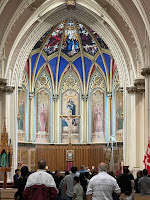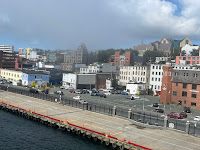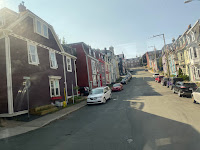After our port of call in Nuuk was canceled, and even after
cruising the Arsuk Fjord, we still had about 1½ sea days of cruising before we
landed in Qaqortoq.
 |
Feeling like the Flying Dutchman!
|
But it wasn’t until we left Qaqortoq that we could see the
ship’s track and the zigzag pattern the ship took to kill the time. We always
knew that the cruise ships would slow walk the route when two ports of call
work relatively close together, but we had never seen this work for more than
an overnight cruise.
So after our stormy departure from Qaqortoq, we had another
full day at sea until we would arrive in St. Anthony, Newfoundland and Labrador.
 |
Hope it's not Wilbur!
|
After a
leisurely breakfast, we spent the morning reading and working on the blog until
it was lunchtime. Lunch presented a rather unique protein alternative in the
form of a roasted suckling pig. The problem was, it seemed that people were
more interested in taking pictures of the animal and they were in requesting a
serving!
The afternoon produced another interesting diversion.
 |
Jane showing her jewels
|
The
ship’s gem expert was putting on a jewelry fashion show that featured his $1
million plus gem collection modeled by ladies he had recruited among the
passengers. And of course, if it involved jewels, Jane would be involved! She
had been recruited to be one of the nine models in the show. Jane had met
Christian, the gem expert, when we were in Russia cruising the Baltic Sea on
the Viking cruise line back in 2018.
The show began with Capt. Larry in attendance (the mandatory
appearance to take pictures!).
 |
All the jewelry models
|
Each model was introduced with a little
background information about her shared with the audience. She then would walk
around the lounge displaying the pieces that she wore. Each model wore pieces that
were collectively valued at over $100,000, which pretty much suppressed any
knee-jerk reaction by the gentleman in the audience to go ripping out their
wallets!
 |
Jane's jewels
|
Capt. Larry had his fun when a lady model from Columbus, Ohio, with a
stated interest in college football, approached him to show her jewels. He
whispered in her ear: “O-H!” And she retorted: “I-O! My God you’re the second
person that’s done that to me!” So you just never know when or where you might
run into another Buckeye. After the models had made their rounds, they posed for
a group photo to end the show.
 |
Jane and Christian
|
Our ship anchored in the harbor of St. Anthony, a town on
the very northern part of the Great Northern Peninsula of the Canadian province
of Newfoundland and Labrador.
 |
St. Anthony
|
St. Anthony has a population of just under 2200
(2021), the largest population center on the peninsula, but the population has
been declining for the past couple of decades.
The town’s history of European settlement dates back to the
early 16th century when French and Basque fishermen used the well-sheltered
harbor as a seasonal fishing station.
 1 1 |
Happy Birthday, Jane!
|
While fishing for years was the economic
mainstay of St. Anthony, tourism has become an important industry as fishing
stocks dwindled.
 |
| Welcome! |
Tourists today come to see the nearby Viking settlement at L’Anse
aux Meadows, a UNESCO heritage site, or to see natural attractions such as
icebergs and whales.
Although St. Anthony has a long history as a fishing
outpost, its history is not complete without a discussion of the town’s most
influential historic figure, Dr. Wilfred Grenfell.
 |
Dr. Wilfred Grenfell
|
After graduating from the
London Hospital Medical School in 1883, Grenfell was sent to investigate the
conditions of fishermen in the Labrador region in 1892, and was said to be the
first doctor to reach the region. Realizing that conditions in the area needed
to be improved, he established a number of hospitals, cooperatives, and schools
for people in remote Newfoundland and Labrador towns.
 |
View of the lake
|
In 1900 Grenfell chose St.
Anthony as headquarters for the Grenfell Mission and acquired the first
hospital ship,
Strathcona 1. He also
established orphanages to care for parentless children in 1905. After his death
in 1940, his contributions to the region are honored by Grenfell Historic
Properties, which comprises the Grenfell Interpretation Center, the Grenfell
House Museum, and the Grenfell Handicraft Store.
 |
Ready for a Canadian winter
|
We tendered over to St. Anthony’s dock and went into the
Grenfell Handicraft Store. Jane started looking for some souvenirs to purchase,
while Capt. Larry went upstairs to the Grenfell Interpretation Center to get
some more information about Dr. Grenfell’s life and mission. After Jane made
her purchases, we left the center to find a small strip mall that we were told
was very close by. We followed a road that took us along the edge of a very
scenic lake.
 |
Beers and a pub band!
|
We came upon a local, after walking a fair distance, and asked him
for directions to the mall. He told us to go up a hill to the main street and
go right to the mall. We got to the top of the hill and it was obvious that
any mall that the locals were talking about was not going to be close by. So we
abandoned our mall hunt and headed back towards the dock. Back at the
Interpretation Center, we came across some fellow passengers that were coming
from the direction opposite ours.
 |
Playing the ugly stick
|
We asked if there was anything worthwhile to
see and were told that the building with the clock steeple had a pub with a
live band.
We arrived at the pub and found the band and the audience to
be in full swing. We got a table and ordered a couple of locally made craft
beers and listened to the band. The duo primarily played Irish ballads and
sailor drinking songs, and encouraged a lot of audience participation. And it
wasn’t long before the audience started to become very raucous.
 |
Jane's birthday necklace
|
They encouraged
audience members to come up one stage and play a unique, percussive instrument
traditionally used by Newfoundlanders—the “ugly stick.” The instrument can be a
mop handle or tree branch with loose flat washers attached that is beat against
the floor in time to the music and produces a percussive sound probably most
similar to that of a tambourine.
 |
Jane's cake
|
And if one doesn’t want to play it, there is
always the option to dance with it! We finished our beers and listened to a
couple more songs, before leaving so someone else could enjoy our table.
Back aboard the ship, we got ready for Jane’s birthday
dinner at the steak and seafood specialty restaurant. She went to the jewelry
boutique to borrow one of the expensive jewelry pieces (a $45,000 pink diamond
necklace) for the evening to celebrate her birthday. We had a very enjoyable
meal that was capped off by the presentation of a birthday cake and the singing
of “Happy Birthday” by the staff.
 |
The celebration continues!
|
We returned to our room and were met in the
hallway by our maid who told Jane that she had a surprise in our room.
 |
Happy birthday!
|
Jane
opened the door to find pink balloons covering the ceiling and a towel turtle on the bed! It was a perfect
gesture to finish off a perfect evening.




























 1
1









